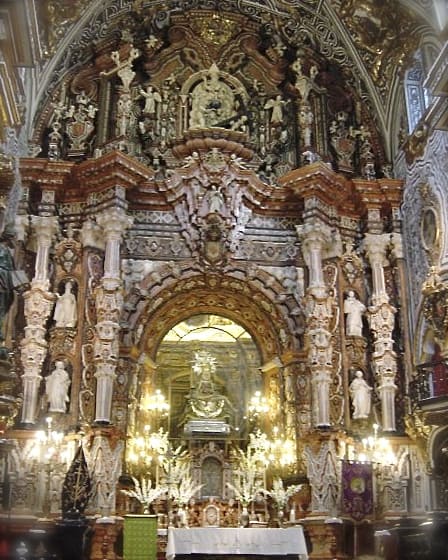The ritual of the Mass in the Catholic Church has a uniformity throughout the world. The prayers follow in a particular order, and if you are visiting a cathedral you can pop your head into a side chapel and know within a minute exactly where the priest is in the order of the Mass, even if you don’t speak the language. There are, however, a number of variations. Sometimes there are extra prayers, before, during and after Mass; and traditions vary on when to sit, stand, or kneel. Fortunately, nuns in Europe still wear habits and the two or three at every Mass are easily identifiable. So, my mantra was, “Follow the nun.” When she sat or knelt, I followed—a failsafe method should you ever require it.
One of my earliest memories of the churches in Spain (from 1972) is the overwhelming amount
 |
|
Gilt Under Guard
|
of gold inside them. On our recent visit the wealth inside the Church was juxtaposed against the beggars sitting outside the church (a sight less visible in the day’s of Franco’s rule). I wonder what Pope Francis has to say about the abundance that is denied the poor. I was also struck by the fact that the bishops sit and kneel on plush cushions, while the congregation sits on hard wooden pews and kneels on unpadded boards.
 |
|
Columbus with Ferdinand and Isabella
|
My conscience was pricked on this visit by the numerous statues of King Ferdinand and Queen Isabella, whose presence is sprinkled throughout Spain’s cities and churches, more than five centuries after their rule. Pope Alexander VI conferred on them the title “Catholic King and Queen” in their lifetime, the assumption being that they were doing God’s work. Today they are still called “the Catholic Monarchs.” When one studies the atrocities they committed, especially the Inquisition, one wonders if that label is one of praise. Because they expelled those of other faiths from the country and segregated those who were not like themselves, I could not help but wonder how much of today’s intolerance between religions can be traced back to them.
 |
|
Courtyard of a historic Jewish home in Cordoba
|
The Sephardic Jews were expelled from Spain in 1492. There is some irony in the date, the
same year that Columbus discovered a land that would be built (after initial atrocities to the native populations) on the principle of freedom and inclusion of all. Since our return an Associated Press story reported that the Spanish government is in the process of passing a law that grants Spanish citizenship to descendants of the Jews who were expelled. It cannot repair the damage but does acknowledge a wrongdoing.
PERSONAL REALIZATION
Sometimes it’s easier to be Catholic in a foreign country. I can figure out the Scriptures and the Mass prayers from past experience, but the preaching is often beyond my understanding of the language. This means I hear no breaches of history or didactic pronouncements that prickle my sense of the real meaning of Christ’s message. (Gary understands more than I, but I don’t ask him to translate. It’s easier that way.)
 |
|
From A Catalonian Cave Church
|





